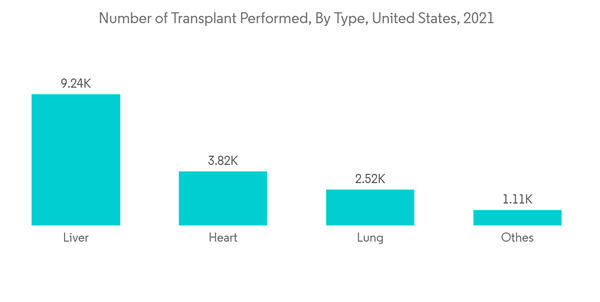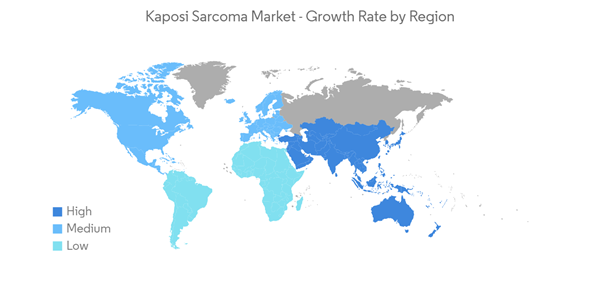Many studies have revealed that the virus that causes COVID-19, severe acute respiratory syndrome coronavirus 2 (SARS-CoV-2), encoded proteins, and various anti-infection medicines have promoted lytic reactivation of Kaposi Sarcoma-associated herpesvirus (KSHV). For instance, according to the study published in Communication Biology in June 2021, researchers discovered that SARS-CoV-2 might cause lytic reactivation of Kaposi Sarcoma. They also discovered that two medications, Nafamostat and Azithromycin, increased the generation of mature virions, potentially generating lytic reactivation of Kaposi Sarcoma. Hence, SARS-COVID-19 treatment may induce Kaposi Sarcoma to impact the market growth during the pandemic significantly. However, the industry has been recovering well since the restrictions were lifted and declining in COVID-19 infection cases. Over the last two years, the market recovery has been led by the high prevalence of Kaposi Sarcoma and new product launches.
The growing prevalence of Kaposi Sarcoma and the rising number of patients undergoing organ transplantation procedures who are more susceptible to Kaposi Sarcoma. These are the major factors attributing to the growth of the Kaposi Sarcoma market. According to the study published in Cancers in November 2021, Kaposi Sarcoma is more common in males who have sex with men (MSM) and in specific locations of the world, such as Sub-Saharan Africa or countries bordering the Mediterranean. The incidence of Kaposi Sarcoma in Sub-Saharan Africa varies according to the area. In Uganda, where the frequency is already high in early childhood, the annual prevalence is 50%. In addition, per the Cancer Get updates in January 2022, in the United States, about one in every 200 transplant recipients gets Kaposi Sarcoma. In 2020, an estimated 34,270 persons were diagnosed with Kaposi Sarcoma worldwide. Thus, the growing prevalence of Kaposi Sarcoma in African countries is expected to drive the demand for Kaposi sarcoma diagnosis and treatment, thereby boosting the market's growth.
Furthermore, a growing number of organ transplants is expected to support market growth. According to the Health Resources and Service Administration, in March 2022, around 40,000 organ transplants were done in the United States in 2021, with 105,800 people on the waiting list for an organ transplant. Thus, an increase in organ transplants is expected to increase the risk of getting affected with Kaposi sarcoma to boost market growth over the forecast period.
However, a shortage in the supply of drugs due to a wide demand-supply gap and the high cost of the treatment and diagnosis of Kaposi Sarcoma will impede the growth of the global market.
Kaposi Sarcoma Market Trends
Chemotherapy Segment Holds a Significant Market Share
Chemotherapy (chemo) is a treatment of cancer-killing drugs used to kill Kaposi Sarcoma cells. The liposomal anthracyclines and taxol class of systemic chemotherapy medications are the most frequently used to treat Kaposi sarcoma (KS). The segment is driven by the rising Kaposi Sarcoma's prevalence and product launches by the key market players.According to the study published in Oncologist in August 2022, total dosages of paclitaxel and carboplatin (PCb) chemotherapy are acceptable when administered concurrently with antiretroviral therapy (ART) in patients with human immunodeficiency virus (HIV) with cancer, including those receiving CYP3A4 inhibitors. Thus, increased adoption of chemotherapy is expected to boost segment growth over the forecast period.
Moreover, according to the study published in Clinical Cancer Research in March 2022, the study concluded that Pomalidomide is a safe and effective chemotherapy-sparing medication for the treatment of Kaposi sarcoma in people with or without HIV. Thus, the effectiveness and safety of chemotherapy agents like Paralidomide are expected to increase the adoption of such chemotherapy agents in the treatment of Kaposi sarcoma, thereby boosting segment growth over the forecast period.
Thus, all the above factors are expected to boost segment growth over the forecast period.
North America Holds Largest Market Share in the Global Kaposi Sarcoma Market
North America holds a significant market share in the Kaposi treatment market globally. Important factors contributing to the growth of the market are the increasing number of product approvals, the presence of many market players, a high number of R&D initiatives undergoing treatment, and the diagnosis of Kaposi Sarcoma. Additionally, the increasing prevalence of Kaposi Sarcoma and HIV is bolstering market growth in the region. According to Statistics published by CDC in September 2022, in the US and dependent regions in 2020, 30,635 individuals obtained an HIV diagnosis. This suggests that HIV incidences are high in the country, increasing the demand for diagnostics products, which will drive the studied market.Furthermore, a growing number of clinical studies in the country will likely support the market's growth. For instance, per the ClinicaTrials.gov updates in July 2022, the study Pomalidomide for Kaposi Sarcoma in People with or Without HIV is under phase II development and expected to launch in the near future. Thus, all the above factors are expected to boost market growth over the forecast period.
Kaposi Sarcoma Market Competitor Analysis
The market studied is a consolidated market owing to the presence of few major market players. Kaposi Sarcoma market has rapidly progressed over the last few years. Industry observed significant changes in adopting market strategies such as product developments, mergers, and acquisitions in recent years. Some of the players include Merck & Co., Inc. Celgene Corporation, Eli Lilly and Company, and among others.Additional benefits of purchasing the report:
- The market estimate (ME) sheet in Excel format
- 3 months of analyst support
This product will be delivered within 2 business days.
Table of Contents
Companies Mentioned (Partial List)
A selection of companies mentioned in this report includes, but is not limited to:
- Merck & Co., Inc.
- Celgene Corporation
- Eli Lilly and Company
- Navidea Biopharmaceuticals, Inc.
- F. Hoffmann-La Roche Ltd
- Bristol-Myers Squibb
- Pfizer Inc.
- Baxter
- Getwell Pharmaceuticals
- Teva Pharmaceutical
- Cipla Ltd










